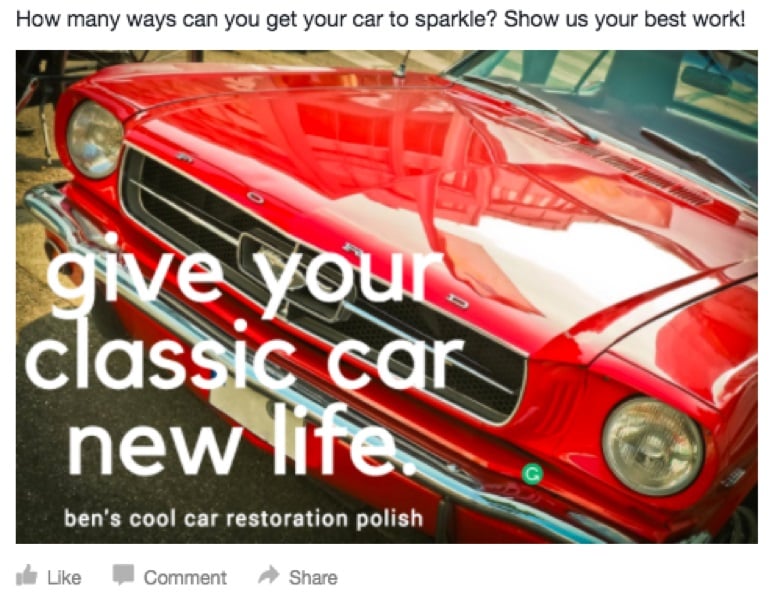Cutting through the noise on social media isn’t easy.
More brands are creating and sharing content now than ever. Plus, social network algorithms (particularly on Facebook) are increasingly clamping down on organic reach.
Indeed, it’s a hostile world out there, and only the best posts rise to the top.
Does that mean you should give up on organic social media marketing? Absolutely not!
Instead of throwing in the towel, it’s time to double down on developing your skills.
And one great place to start is learning how to write better social media copy.
Follow along with us and we’ll explain:
- Why writing well matters on social media.
- What are the most important copywriting best practices to remember on each social network?
- Who is your real social media audience (and how can you reach them)?
Get ready to fire up your keyboards and light up your follower’s social feeds. We’re about to make you a master social media wordsmith.
Want to plan and schedule your social media content in advance? Here's your step-by-step guide!
How to Write Better Social Media Posts (And Cut Through The Noise!)
Getting Started: Social Media Writing Mechanics
Are you just winging it when writing social media copy?
There’s a better way: planning all your content (text, images, links, and all) ahead of time.
This gives you the opportunity to craft thoughtful copy that’s more likely to stand out and resonate with your audience.
Before you can wow your audience with crisp, creative copy though, it helps to understand some basic social media writing best practices.
Sticking Within Character Limits
Different social media networks have different character limits.
Some of these are high enough to be effectively irrelevant (like on Facebook), while others are integral to how those networks function (like on Twitter).
Here’s a quick look at your character limits on each major network:
/Picture1.png?width=832&height=492&name=Picture1.png) Some of these are of little consequence (if you’re somehow writing 63,000+ character Facebook posts, I’d like to introduce you to blogging instead).
Some of these are of little consequence (if you’re somehow writing 63,000+ character Facebook posts, I’d like to introduce you to blogging instead).
Others, though, like Twitter’s iconic 140-character limit, place intentional restraints on your writing (ensuring you get to the point).
Understand Optimal Post Lengths
So, we know how much room we have to work with on each network.
However, that doesn’t tell us much about optimal character counts, though.
Compelling content will beat sound mechanics any day of the week. Writing posts that fit within a certain number of letters and words will not automatically lead to more success.
But, knowing which ranges typically work best can help tilt the odds in your favor.
With that said, let’s take a look at some data-driven recommendations for post length, per network.
Facebook:
/Picture2.png?width=832&height=340&name=Picture2.png)
Twitter:
/Picture3.png?width=832&height=340&name=Picture3.png)
Instagram:
/Picture4.png?width=832&height=340&name=Picture4.png)
Pinterest:
/Picture5.png?width=832&height=340&name=Picture5.png)
LinkedIn:
/Picture6.png?width=832&height=340&name=Picture6.png)
Google+:
/Picture7.png?width=832&height=340&name=Picture7.png)
What About Image Copy?
In addition to writing social media post copy and captions, you may also need to consider text on images themselves.
Mechanics-wise, the one key takeaway to remember here is this: Facebook ads and boosted posts place a 20% image text overlay restriction.
This means if more than 20% of your image is covered in text, your post will receive reduced reach. That’s bad news if your goal is to cut through the static in your fan’s feeds.
Even if you’re creating 100% organic posts without paid promotion, on any network, it’s worth being mindful of how much text you apply to images.
With exceptions for quote graphics (which have become borderline-cliched on social media—again, not ideal if your goal is to stand out), too much text can look garish.
Define Your Social Media Voice and Tone
Your social media post copy should sound like your brand.
But, you might not always sound exactly the same on social as you do on other channels.
Make sure every post you write is on-point by paying attention to your voice and tone. These are two related, but distinct, concepts that often get conflated with one another.
Here’s how we can define them both:
- Voice: Your brand’s overall style and personality. What do you sound like on social media?
- Tone: The emotion or inflection you apply to your voice. This will change based on the context of each post you publish.
This graphic illustrates how voice and tone overlap and intersect:
/Picture8.png?width=832&height=695&name=Picture8.png)
Write for the Right Audience
If you’re writing for everyone, you’re effectively writing for no one at all.
You need to write every post for the right audience. And the right audience is whoever is most likely to buy your stuff and advocate for your brand.
If your organization has done any audience research in general, leverage that when creating social content. It’s possible, though, that your specific audience on social media is slightly different than your audience as a whole.
For example, you might find that certain demographics follow you on Twitter, while others are bigger fans of your Facebook page. In turn, your ideal audience on each social network may be different than folks on your email list, reading your blog, and so forth.
So, it’s worth taking time to understand who exactly you’re talking to on each network.
Start By Building a Social Media Audience Persona
If you’ve been in the marketing game for any length of time, odds are you know about personas.
They’re essentially brief character descriptions of the average person you’re trying to reach.
A basic persona should be a document that covers the following information:
- Age
- Sex/gender
- Location
- Occupation
- Interests and hobbies
- Problems and pain points
You can get more detailed if you like, but in general, this covers the high-level items your persona should include.
Since this process deserves a post (or two, or three … ) on its own, check out this guide from Column Five Media and this one from Clickz to build yours quickly and easily.
Know the Right Verbiage Your Audience Uses
Brands oftentimes approach social media as if they’re talking to stereotypical Millennials at all times.
How often have you seen, say, a local HVAC company or a 50-year-old legacy brand drop a “bae” or seven fire emojis into a tweet for no reason? Or something equally egregious?
Probably a few times too many.
Snark and pop culture rule the day on a lot of people’s social media feeds. However, that doesn’t mean your writing needs to follow suit.
In fact, you’re probably a lot less likely to stand out from the onslaught of memes and GIFs if all you’re doing is resharing the same stale stuff and shoehorning in a connection to your brand somehow.
Instead, smart marketers use the same language their actual audience uses. Here are some tips to help you cop your audience’s word choice:
- Spend time scanning your follower’s social profiles. Make note of what kinds of things they say, what they talk about, and the language they use to describe anything related to your brand, product, or industry.
- Read the same websites and publications your audience does. That could include news sites, blogs, and industry publications.
- Build a scratch file of commonly used terms and language. This doesn’t have to be super formal, but jotting down commonly used terms and phrases somewhere can be helpful here.
Now, as a marketer, you might find yourself writing about industries you know nothing about, for people who are nothing like you.
The more this is true, the more homework you’ll have to ensure your copy is on-target.
Craft Social Media Messaging That Speaks To Audience Interests Pain Points
Once you know who your audience is and what kind of language they use, make sure your messaging is targeted toward:
- Their interests. What kinds of things does your target audience like?
- Their pain points. What kinds of problems do they face that your product or service can address?
Let’s take this tweet from Microsoft for example:
They wanted a world without bullying, so they built one in VR. Now, our #MakeWhatsNext Patent Program is helping them protect their idea. pic.twitter.com/Wr5Gw8yhd4
— Microsoft (@Microsoft)
- Identified a problem their audience relates to. Most of us can agree bullying is a problem (and one that’s getting worse), and we want to do something about it.
- Showed how someone used a product they’re involved with to solve that problem. This is a great example of VR being used for something more than just entertainment. For a company that makes a lot of practical and business-minded products (excluding Xbox and games for a moment), showing off VR’s utility in innovative ways is likely important for Microsoft.
- And they’ve done it all with well-written post copy accompanying a great video. The post text is crisp and clear, and the video is polished.
When writing your own social posts, try following this formula:
[PROBLEM] + [SOLUTION] + [URL/CTA].
Here’s a hypothetical example diagramming this formula in action:/Picture9.png?width=832&height=416&name=Picture9.png)
Understand Basic Social Media Writing Best Practices
No matter what network you’re on, there are some basic principles that well-written posts follow.
Let’s cover some basics (including some that apply more broadly to content and copywriting and general, as well as on social media).
Optimize Every Post With the Social Message Optimizer
The easiest way to make every post you publish mechanically sound is to use the Social Message Optimizer.
This free online tool makes it simple to enter your post copy and get a thorough analysis quickly:/Picture10.png?width=832&height=745&name=Picture10.png)
Enter your post text and click Score My Message. Then, you’ll get a score for your post across each major social network:/Picture11.png?width=832&height=128&name=Picture11.png)
Next, you’ll see an in-depth analysis of your post:
/Picture12.png) That’s followed by a breakdown of your post type, character count, and hashtag usage:
That’s followed by a breakdown of your post type, character count, and hashtag usage:/Picture13.png?width=832&height=387&name=Picture13.png) You’ll also see an analysis of your post’s sentiment to make sure you’re targeting the right emotional trigger points to drive engagement:
You’ll also see an analysis of your post’s sentiment to make sure you’re targeting the right emotional trigger points to drive engagement:/Picture14.png?width=832&height=773&name=Picture14.png)
Finally, you’ll get some quick pointers on how to optimize your post timing and schedule:/Picture15.png?width=832&height=766&name=Picture15.png)
Pay Attention to Message Match
You’ve written a killer post and it’s driving tons of traffic back to your site (or maybe a campaign landing page).
There’s just one problem: your copy isn’t relevant to the page it’s linked to.
This kind of oversight is way too common. Fortunately, it’s easy to avoid.
When you’re writing social posts, keep the following two points in mind:
- What kind of messaging is on the page I’m linking to? This sounds like a basic question to ask. However, it’s enough to help you avoid headaches later.
- Does the voice and tone match the destination page? A light and fun social post linking to a dead-serious fundraising landing page for heart disease research (for example) isn’t likely to go well. Match the sentiment to the page you want people to visit.
Here’s an example of strong message match in action from Ford Motor Company:
How can we create the #CityofTomorrow together? Join the conversation as we explore the possibilities. https://t.co/SYGt0LwAbK
— Ford Motor Company (@Ford) August 15, 2017
Once readers arrive on the destination page, the headline makes it immediately clear that the tweet delivered on its promise to show them something relevant: /Picture19a.png?width=832&height=177&name=Picture19a.png)
This tweet also accomplishes the following:
- Establishes a problem to be solved.
- Sets up a call-to-action that leads users to find the answer.
- Delivers with a link that continues to discusses the issue at hand, matching the tone and sentiment of the social post.
It’s not rocket science, it isn’t ground-breaking, and it doesn’t need to be. It’s just well-written and compelling content that speaks to the reader’s interests.
Use Active Voice
Social media is action-driven. It moves fast and you often have little time to hook people’s attention. So, to keep your post copy gripping and intriguing, use active voice over passive voice.
If you need a refresher on active vs. passive voice, let’s take a step back to high school English class (and personally, this writer never gave their high school English teachers enough credit):
- Active Voice: The subject of the sentence performs the action.
- Passive Voice: The subject of the sentence has an action performed onto it.
What does this actually sound like in real life? Here’s two takes on one post in active and passive voice:
- Active: “Our car cleaning polish gets finishes looking 75% more glossy.”
- Passive: “The car was cleaned using the polish that’s 75% better.”
In the first example, the subject (car cleaning polish) performs the action (getting car finishes looking 75% better). The post copy in the second example, however, has the subject (the car) being acted upon by the polish.
As a result, it sounds less action-driven and sounds, well, awkward.
Use Emojis (Tastefully)
Did you know emoji is considered its own language?
It might sound weird, but those little emotive icons have taken on a life of their own.
And they can be surprisingly effective for infusing feeling into your posts.
The key is to use them tastefully and effectively./Picture16.png?width=832&height=492&name=Picture16.png)
Say More With Fewer Words
Use only as many words as you need to make your point.
This doesn’t necessarily mean writing short every time. It does, however, mean that anything extraneous should be removed from your posts. Crisp and clear copy will cut through the crap more easily than something difficult to read.
As an exercise, review every post you write. Then, eliminate every possible word you can, without losing the meaning and intent behind your message.
For example, let’s say your post starts like this:
“How many different ways can you possibly wash your car with our latest car polishing product? Let’s count them all!”
So, there’s plenty of opportunity to cut out some text here. We can start with the first sentence. Which words could we delete without losing meaning?
- Different
- Possibly
So, let’s cut those two words out and see how this sounds:
“How many ways can you wash your car with our latest car polishing product?”
That definitely sounds tighter, right? It’s still a little clunky though, and lacking the creative sizzle social media audiences typically expect. The last part of this sentence could probably be switched up to focus more on benefits, and less on the product itself.
Another pass at this post might sound like this:
“How many ways can you get your car to sparkle?”
Now, we’ve got a creative adjective (“sparkle”) in there, and we’ve conveyed a clear benefit to our reader. With our second sentence, we’ll put some spin on our CTA:
“Show us your best work!”
Let’s put it all together:
“How many ways can you get your car to sparkle? Show us your best work!”
We’ve now taken a clunky piece of copy, tightened it up, and given our audience a call to get involved that lets them show themselves off (instead of just promoting the product).
The accompanying image could do that instead, displaying the product in use, along with some crafty copy on the graphic itself.
Here’s a quick mockup I made using Canva and a free stock photo from Pexels: 
I spent about five minutes on this example (for demonstration purposes), so obviously, it doesn’t look or read the best.
But, this process should give you an idea how you can make your posts more concise, creative, and effective all at the same time.
Plan Cohesive Campaigns to Drive Your Message Home
Social media posts have a short lifespan. According to Moz, a tweet’s visibility lasts about 18 minutes. That isn’t a lot of time to get attention to your post (and drive traffic toward a conversion step).
What’s the solution? Write coordinated campaigns that drive home one consistent message across multiple posts (and maybe even multiple networks).
First, you’ll need to plan a campaign idea intended to promote a specific message, goal, or piece of content. That’s worth an entire post by itself though, and you can find one right here.
For the scope of this post, we want to focus on writing for social media itself. So, once you have a campaign idea generated or a creative brief to follow, start by creating a Word or Google doc.
Next, write each post as if it were a piece of a greater whole. Keep your messaging consistent, driving home one point in sequential order from one post to the next. For each post, include: /Picture18.png?width=832&height=567&name=Picture18.png)
- Post Copy. This is the actual text of your post.
- Link URL: If your post will direct to another page, include the link.
- Image Direction: Make sure your designer has an idea of what you want your graphic to look like. If your image will have text on it, include that as well.
Once you start crafting your social content, your doc will start to look something like this:/Picture19.png?width=832&height=583&name=Picture19.png)
Again, these are quick examples, but the key takeaways are:
- Write multiple posts pushing one message. That will increase the chances your message gets heard.
- Don’t just wing it with each post, though. Put some time and thought into your content.
- Think through your images (and corresponding image copy) too. Do better than just slapping a witty caption onto a random GIF that has nothing to do with your business.
Map Social Posts to Your Content Calendar
Finally, once you’ve written your posts, it’s time to map them out on your social media calendar.
If you need a social media calendar template, you can grab one free here (hosted via public Google Sheets file). Here’s what it looks like: /Picture20.png?width=832&height=354&name=Picture20.png)
Go Forth And Out-Write Your Competition
Now that you’ve got all the knowledge and tools you need to write better social media content, there’s only one thing left to do.
That, of course, is get down to work!
If you have any awesome tips we missed, drop a comment below and help get the conversation started.
Best of luck!








ViewHide comment (1)